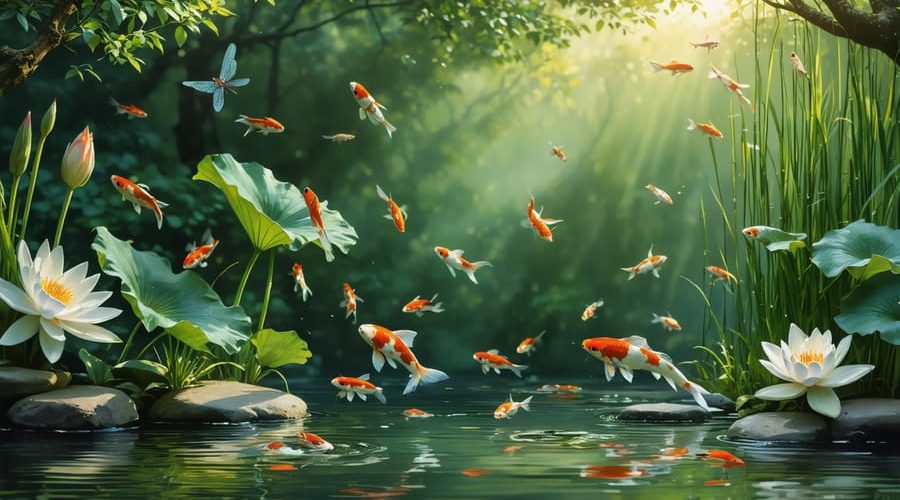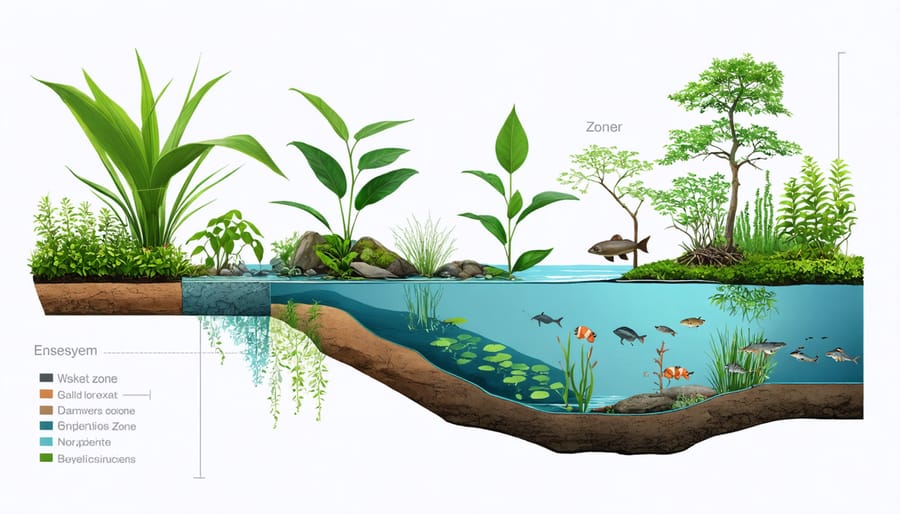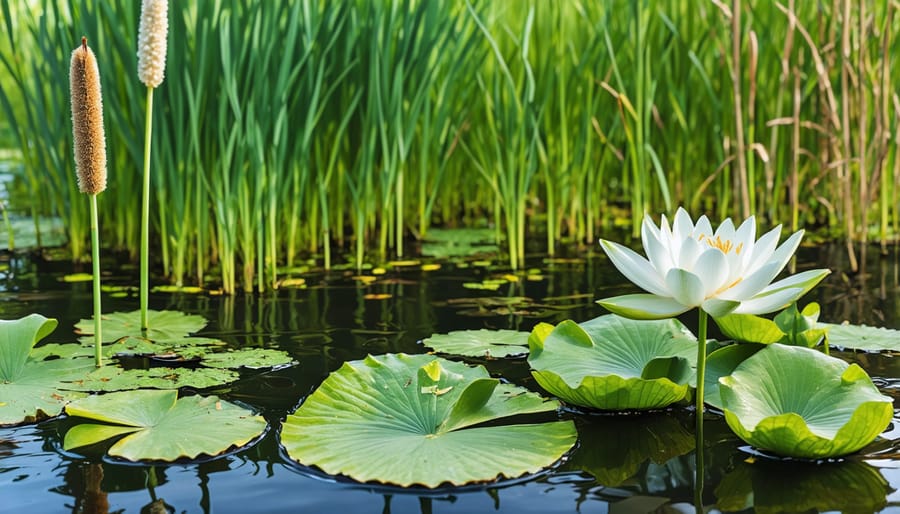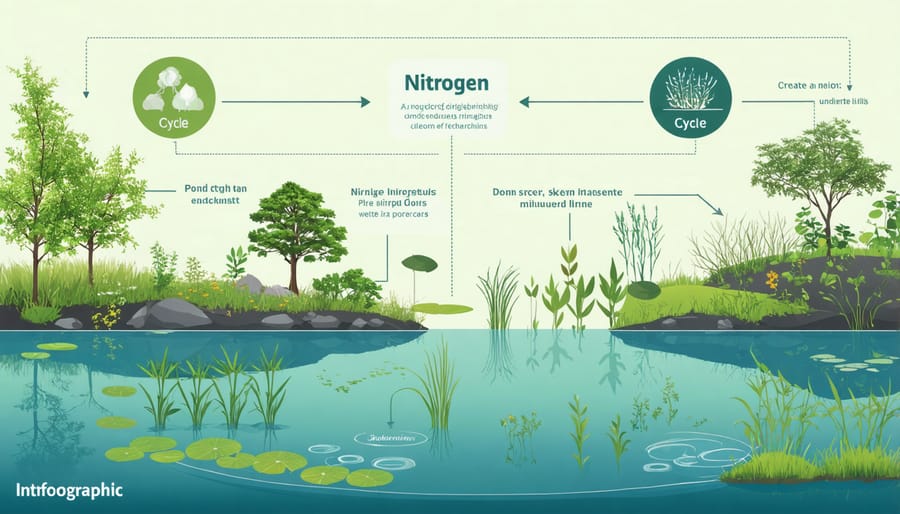
Transform Your Backyard into a Thriving Pond Ecosystem
A pond ecosystem is nature’s perfect miniature world, where water, plants, animals, and microorganisms work together in remarkable harmony. Like a living, breathing organism, these small aquatic environments create self-sustaining cycles that support diverse life forms, from colorful koi fish to delicate water lilies. Whether natural or man-made, pond ecosystems demonstrate the intricate balance of life, where each component plays a vital role in maintaining the health and stability of the entire system.
In this carefully orchestrated dance of nature, sunlight powers photosynthesis in aquatic plants, fish and insects create natural fertilizer, and beneficial bacteria break down organic matter into nutrients. This continuous cycle creates a thriving habitat that not only provides a home for various species but also serves as a valuable learning tool for understanding larger ecological systems. Understanding how these elements interact is crucial for anyone interested in creating or maintaining their own backyard water feature, as it helps ensure a balanced and sustainable aquatic environment.

The Building Blocks of a Pond Ecosystem
Water Quality and Circulation
A healthy pond ecosystem depends heavily on proper water quality parameters and circulation. Think of water movement as your pond’s circulatory system – it keeps everything flowing and balanced. Good circulation helps distribute oxygen throughout the water, prevents stagnant areas where algae can bloom, and maintains consistent temperatures from top to bottom.
Key factors like pH, dissolved oxygen, and temperature need to stay within specific ranges to support aquatic life. A properly functioning pond should maintain a pH between 6.5 and 8.5, while oxygen levels should stay above 6 parts per million for fish to thrive. Temperature stratification – where warmer water sits on top of cooler layers – can be prevented with proper water movement.
Pumps and waterfalls aren’t just beautiful features; they’re essential for maintaining this delicate balance. They create surface agitation that increases oxygen exchange and helps beneficial bacteria process waste. Even small ponds benefit from having some form of circulation to keep the ecosystem healthy and vibrant.
Plants and Their Roles
Plants are the backbone of any healthy pond ecosystem, performing multiple vital functions. You’ll typically find three main types of aquatic plants in a pond: submerged, floating, and marginal plants. Submerged plants like hornwort and anacharis grow completely underwater, providing oxygen and shelter for fish and other aquatic life. They also help keep algae in check by competing for nutrients.
Floating plants, such as water lilies and lotus, spread their leaves across the water’s surface, offering shade that keeps pond temperatures stable and reduces algae growth. Their beautiful flowers add visual appeal while providing landing spots for dragonflies and other beneficial insects.
Marginal plants grow along the pond’s edges, where they help stabilize banks and filter runoff water before it enters the pond. Plants like cattails, iris, and rushes create natural transitions between water and land while offering hiding spots for wildlife. These plants also absorb excess nutrients that might otherwise feed problematic algae blooms.
Together, these plant types create a balanced ecosystem that’s both functional and beautiful.

The Living Components
Fish and Other Aquatic Life
A thriving pond ecosystem is home to a diverse range of fish and other aquatic creatures that work together to maintain balance. Common fish species like goldfish and koi are popular choices, not just for their beautiful colors but also for their ability to help control algae and insect larvae. These fish adapt well to pond life and can survive through different seasons when properly cared for.
Beyond fish, you’ll find fascinating creatures that naturally make their way to your pond. Frogs and toads are welcome residents that help control insects and add pleasant evening sounds to your garden. Dragonflies and damselflies dart above the water, their larvae living below the surface and feeding on mosquito larvae. Water snails act as natural cleaners, consuming algae and dead plant material.
In deeper layers, you might spot crayfish and freshwater shrimp, which help break down organic matter and keep the pond floor clean. Various aquatic insects like water boatmen and diving beetles create a complex food web that supports the entire ecosystem.
When stocking your pond with fish, remember to maintain proper population levels – typically one inch of fish per square foot of surface area. This helps prevent overcrowding and maintains good water quality. It’s also important to introduce species gradually, allowing the ecosystem to adjust and establish natural balance over time.
Beneficial Microorganisms
While they might be invisible to the naked eye, beneficial microorganisms are the unsung heroes of your pond ecosystem. These tiny life forms, primarily bacteria and other microscopic organisms, work tirelessly to maintain the delicate balance that keeps your pond healthy and thriving.
The most important players are the beneficial bacteria, which perform two crucial functions. First, they break down fish waste, fallen leaves, and other organic matter that would otherwise pollute your pond. Second, they convert harmful ammonia (from fish waste) into less dangerous compounds through a process called the nitrogen cycle.
Think of these microorganisms as your pond’s natural cleaning crew. They colonize your filter media, rocks, and plant roots, forming invisible but essential biofilms. These bacterial colonies help prevent algae blooms by competing for nutrients and keep your water crystal clear naturally.
Other beneficial microorganisms include protozoa and certain types of fungi, which help decompose organic matter and contribute to the food chain. They serve as food for larger organisms like small crustaceans, which in turn feed your fish.
To keep these helpful microorganisms thriving, avoid using harsh chemicals in your pond and maintain consistent water conditions. Adding beneficial bacteria supplements during spring startup or after major cleanings can help jumpstart these essential colonies and maintain your pond’s natural balance.
Natural Cycles in Your Pond
The Nitrogen Cycle
The nitrogen cycle in a pond is like nature’s own recycling system, constantly converting different forms of nitrogen to keep your pond healthy. It starts when fish waste, uneaten food, and dead plant material release ammonia into the water. While ammonia is harmful to fish, beneficial bacteria in your pond come to the rescue by converting it to nitrites. These nitrites are still toxic, but don’t worry – a second group of helpful bacteria transforms them into nitrates, which are much safer for pond life.
Plants love these nitrates and use them as food for growth, helping to clean the water naturally. Some bacteria can even convert nitrates back into nitrogen gas, which returns to the air, completing the cycle. This process happens continuously in a well-balanced pond, creating a self-sustaining ecosystem. To help maintain a healthy nitrogen cycle, avoid overfeeding your fish, maintain adequate plant life, and never clean your filter media with tap water, as this can kill the beneficial bacteria that make this amazing process possible.

Oxygen and Carbon Dioxide Exchange
In a pond ecosystem, the exchange of oxygen and carbon dioxide plays a vital role in supporting all forms of life. During daylight hours, aquatic plants and algae perform photosynthesis, releasing oxygen into the water while absorbing carbon dioxide. This process creates a natural balance that fish and other aquatic creatures depend on for survival.
At night, the process reverses – plants consume oxygen and release carbon dioxide, just like the pond’s animal inhabitants do continuously. This is why proper pond aeration is essential for maintaining healthy oxygen levels around the clock.
Wind action on the water’s surface also helps mix atmospheric oxygen into the pond, while decomposing organic matter at the bottom consumes oxygen. In warmer months, when water holds less dissolved oxygen and fish are more active, this natural cycle becomes even more critical. A well-balanced pond will maintain sufficient oxygen levels through these natural processes, supporting a thriving ecosystem where all inhabitants can flourish.
Signs of a Healthy Pond Ecosystem
A healthy pond ecosystem reveals itself through several key indicators that pond enthusiasts can easily observe. Clear water that maintains its transparency while still having a slight green tint is one of the most visible signs of good health. You should be able to see about 12-18 inches deep into the water, though this may vary seasonally.
Thriving aquatic plants are another positive indicator – look for steady growth without excessive algae takeover. A mix of floating, submerged, and marginal plants shows good balance. Healthy plants will have bright, vibrant colors and show consistent new growth throughout the season.
Your fish should be active, displaying natural behaviors and healthy appetites. They should swim at various depths rather than staying exclusively at the surface gasping for air. Watch for any unusual swimming patterns or lethargy, which could indicate problems.
A diverse population of insects and small creatures is excellent news for your pond. Dragonflies, water beetles, and freshwater snails are nature’s cleanup crew and help maintain the ecosystem’s balance. Their presence typically indicates good water quality and oxygen levels.
However, be alert for signs of nutrient imbalance, such as excessive algae growth or floating organic debris. Regular monitoring of these indicators helps you catch potential issues early. The bottom of your pond should have minimal sludge buildup, and there shouldn’t be any unpleasant odors wafting from the water.
Remember that seasonal changes are normal, but dramatic shifts in any of these factors might signal the need for maintenance or adjustment to your pond’s care routine.
A pond ecosystem is truly a fascinating miniature world that brings life and beauty to any outdoor space. From the gentle splash of fish to the buzzing of dragonflies, each element plays a vital role in maintaining this delicate balance of nature. By understanding the basic components – water quality, plants, fish, and beneficial microorganisms – you can create and maintain a thriving pond ecosystem in your own backyard. Remember, starting small and gradually building your pond’s ecosystem allows you to learn and adjust as needed. Whether you’re interested in water gardening for its aesthetic appeal or passionate about creating a wildlife habitat, maintaining a pond ecosystem is a rewarding journey that connects you with nature. Take that first step today, and watch as your pond transforms into a vibrant, self-sustaining ecosystem that brings joy year after year.
